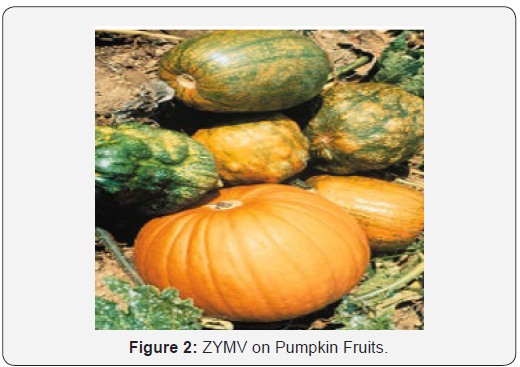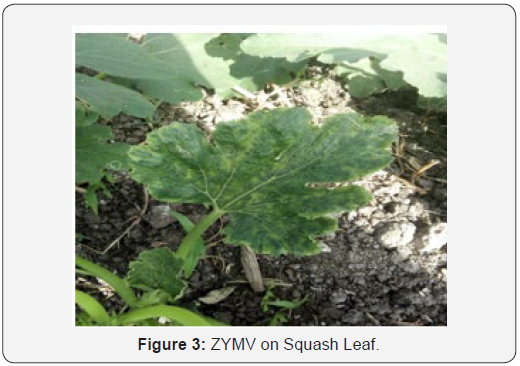Incidence and Disease Control of Zucchini Yellow Mosaic Potyvirus
Mahmoud Hamdy Abd El-Aziz*
Plant Pathology Institute, Agricultural Research Center, Egypt
Submission: October 23, 2019; Published: November 08, 2019
*Corresponding author: Mahmoud Hamdy Abd El Aziz, Plant Pathology Institute, Agricultural Research Center, Alexandria, Egypt
How to cite this article: Mahmoud Hamdy Abd El-Aziz. Incidence and Disease Control of Zucchini Yellow Mosaic Potyvirus. JOJ Wildl Biodivers. 2019: 1(5): 555574. . DOI: 10.19080/JOJWB.2019.01.555574
Abstract
Zucchini Yellow Mosaic Potyvirus (ZYMV) was first identified in northern Italy. It likes other species of the family Potyuiridue. ZYMV has been recorded in many countries since 1981. The efficient intercontinental spread of the virus can be explained by international trading of infected seeds. Since Coat Protein (CP) analysis has become a primary method for taxonomic assignment of potyviruses the aims were to characterize this genomic region of ZYMV originating from virus-infected cucurbitaceous seedlings. Virus infection in cucurbits is typically associated with mosaic symptoms on leaves and lumpy, distorted fruit. The range of symptoms produced by each virus can overlap and plants are commonly infected by more than one virus at once. The viruses are spread by many species of aphids moving through or within a crop. Control options include destroying old cucurbit crops as soon as harvesting is completed destroying weeds and volunteer cucurbits, within and around crops as these harbors the viruses and/or the aphids separating new crops from maturing crops as these will have high levels of virus infection avoiding overlapping crops of cucurbits
Introduction
Zucchini Yellow Mosaic Potyvirus (ZYMV) like other species of the family Potyuiridue Lisa & Lecoq [1] is transmitted by aphids in a non-persistent manner. The virus was first reported in Italy in 1973 Lisa et al. [2] but ZYMV causes devastating epidemics in commercial cucurbits worldwide and several biologically distinct strains have been described Lisa & Lecoq [1], Greber et al. [3], Wang et al. [4] and Tóbiás & Palkovics [5]. ZYMV has been recorded in Australia since 1981 Greber et al, [3] but no molecular analysis of sequence variability has been done. Zucchini Yellow Mosaic Potyvirus (ZYMV) was first identified in northern Italy (Figure 1). Soon after, it was identified in areas throughout the world where cucurbits are cultivated, including Mediterranean countries, Japan, Germany, Central Europe, China, Chile, Australia, Mexico, Mauritius, Canada and the USA Desbiez & Lecoq [6] and Prieto et al, [7]. This relatively new, but aggressive virus (member of the potyvirus group) has spread rapidly throughout the world, suggesting an efficient transmission from plant to plant by several aphid species in a nonpersistent manner Lisa & Lecoq [1] and long distance distribution via infected seeds Davis & Mizuki [8]; Schrinjwerkers et al, [9], Fletcher et al,[10]. The efficient intercontinental spread of the virus can be explained by international trading of infected seeds. However, the rate of disease transmission via seed is low and difficult to prove Provvidenti & Robinson [11] Gleason & Provvidenti [12]; Robinson et al, [13]. There is some evidence for seed transmission in the case of zucchini Davis & Mizuki [8] Schrinjwerkers et al, [9] buttercup squash Fletcher et al, [10] and hulless oilseed pumpkin Burgmans & Fletcher [14] and Tóbiás & Kovács [15]. This work focused on studying the seedborne virus transmission on hulless oilseed pumpkin, (Figure 2) the effect of storage time on the rate of virus transmission via infected seeds, and characterization of the virus isolates transmitted by seeds. Since Coat Protein (CP) analysis has become a primary method for taxonomic assignment of potyviruses the aims were to characterize this genomic region of ZYMV originating from virus-infected cucurbitaceous seedlings Choi et al, [16]. Virus infection in cucurMini bits is typically associated with mosaic symptoms on leaves and lumpy, distorted fruit. The range of symptoms produced by each virus can overlap and plants are commonly infected by more than one virus at once.



The role of aphids in spreading the viruses
The viruses are spread by many species of aphids moving through or within a crop. The aphids pick up the virus after feeding on infected leaves for only a few seconds and remain capable of spreading the virus for up to several hours after feeding. Winged aphids may be carried several kilometers by wind. In this way, small numbers of aphids can successfully spread the viruses to large numbers of plants. As a result, devastating crop losses can occur without significant numbers of aphids being observed. Most commonly, virus is spread by aphid species which do not settle and establish a colony within a crop but move from plant to plant, briefly tasting as they search for suitable host plants Sammons & Schrijnwerkers et al, [9,17].
Disease Control
All viruses can be managed using the same methods. As the greatest yield losses occur when plants are infected early in life, control measures are aimed at delaying and minimising the levels of virus within crops. No single measure provides complete control and integrating multiple measures will provide better control. Control options include: destroying old cucurbit crops as soon as harvesting is completed destroying weeds and volunteer cucurbits within and around crops as these harbor the viruses and/or the aphids separating new crops from maturing crops as these will have high levels of virus infection avoiding overlapping crops of cucurbits, particularly zucchini arranging sequential plantings so that younger plantings are upwind of older crops separating crops, for example by using blocks of non-susceptible crops using resistant or tolerant varieties (Figure 3). These are available for all three viruses in pumpkin and zucchini using super-reflective plastic mulches, as these deter aphids from landing on leaves and can delay disease development in zucchini and other cucurbit species which do not rapidly cover the mulched area combing super- reflective mulches with weekly applications of stylet oil, applied to cover leaf surfaces thoroughly. Regular insecticide applications generally have little effect on the spread of these viruses, as it usually occurs with very short feeding times. Some insecticides actually increase virus spread as the chemicals agitate the aphids causing more frequent movement and feeding. Virus diseases are a worldwide problem of cucurbits and a major limiting Factor for cucurbit production approximately 35 viruses infecting cucurbits worldwide Provvidenti [18].
References
- Lisa V, Lecoq H (1984) Zucchini yellow mosaic virus. CMI/AAB Description of Plant Viruses Kew, Surrey (GB).
- Lisa V, Boccardo G, D Agostino G, Dellavalle G, D Aquilio M (1981) Characterization of a potyvirus that causes zucchini yellow mosaic. Phytopathology 71: 667-672.
- Greber R, McLean G, Grice M (1987) Zucchini yellow mosaic virus in three States of Australia. Australasian Plant Pathology 16(1): 19-21.
- Wang HL, Gonsalves D, Provvidenti R, Zitter TA (1992) Comparative biological and serological properties of four strains of zucchini yellow mosaic virus. Plant Disease 76: 530-535.
- Tóbiás I, Palkovics L (2003) Characterization of Hungarian isolates of zucchini yellow mosaic virus (ZYMV, potyvirus) transmitted by seeds of Cucurbita pepo var. styriaca. Pest Manag Sci 59: 493-497.
- Desbiez C, Lecoq H (1997) Zucchini yellow mosaic virus. Plant Pathol 46: 809-829.
- Prieto H, Bruna A, Hinrihsen P, Munoz C (2001) Isolation and molecular characterization of a Chilean isolate of Zucchini yellow mosaic virus. Plant Dis 85: 644-648.
- Davis RF, Mizuki MK (1986) Seed transmission of zucchini yellow mosaic virus in squash. Phytopathology 76: 1073.
- Schrijnwerkers CCFM, Huijberts N, Bos L (1991) Zucchini yellow mosaic virus: two outbreaks in the Netherlands and seed transmissibility. Neth J Pl Path 97: 187-191.
- Fletcher JD, Wallace AR, Rogers BT (2000) Potyviruses in New Zealand buttercup squash (Cucurbita maxima Duch): yield and quality effects of ZYMV and WMV2 virus infections. New Zealand J Crop Horticult Sci 28: 17-26.
- Provvidenti R, Robinson RW (1987) Lack of seed transmission in squash and melon plants infected with zucchini yellow mosaic virus. Cucurbit Genet Coop Rpt 10: 81.
- Gleason ML, Provvidenti R (1990) Absence of seed transmission of zucchini yellow mosaic virus from seed of pumpkin. Plant Disease 74: 828.
- Robinson RW, Provvidenti R, Shail JW (1993) Tests for seed born transmission of Zucchini yellow mosaic virus. Hortscience 28: 694-696.
- Burgmans J, Fletcher J (2000) Virus infections levels of oilseed pumpkin in New Zealand. Cucurbit Genet Coop Rpt 23: 112-113.
- Tóbiás I, Kovács G (2001) Seed transmission of zucchini yellow mosaic virus new viral pathogen on cucurbitaceous Növényvédelem (Plant Protection) 37: 29-31 (in Hungarian).
- Choi SK, Choi JK, Park WM, Ryu KH (1999) RT-PCR detection and identification of three species of cucumo viruses with a genus-specific single pair of primers. J Virol Methods 83: 67-73.
- Sammons B, Barnett OW, Davis RF, Mizuki MK (1989) A survey of viruses infecting summer squash in South Carolina. Plant Disease 73: 401-404.
- Provvident R (1996) Diseases caused by virus. In: Hopkns Dl, Thomas CE, Zitter TA, (Eds.), Compendium of cucurbit diseases, APS Press, Minnesota, USA, p. 37-45.






























